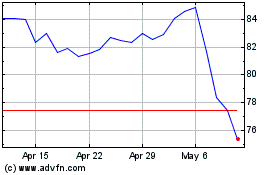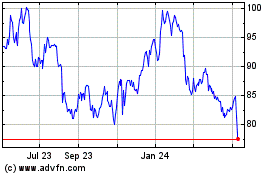After several years spent lost in the shuffle of Android handset
makers, LG Electronics Inc. is giving up on the China market and
making a renewed push in the U.S. with a high-end flagship
smartphone, in a bid to regain the world's No. 3 spot.
LG's G5 smartphone, launched on the sidelines of the Mobile
World Congress in Barcelona, has a radically different design that
has won plaudits from critics, bolstering investor hopes that the
South Korean company may have finally found its hit phone. LG needs
a best seller as its mobile unit has posted losses for the past two
quarters.
The metal-framed G5 has a modular design, which allows users
to easily swap in accessories like a camera pack with an optical
zoom, a high-fidelity audio booster or an extra battery.
In its efforts to make the G5 a hit, LG executives said the
company is planning simultaneous launches in the U.S., Europe and
South Korea, working with 200 carrier partners when the phone goes
on sale in April.
"We want to give it a big drive this time, setting aside more
budget for marketing than we could probably afford," said Juno Cho,
LG's mobile chief, without disclosing specific figures.
Mr. Cho was named LG's mobile chief at the end of 2014, largely
due to his experience in the U.S. He spent four years as an
executive involved in setting business strategies for LG's North
American operations.
But LG has a lot of catching up to do. Last year, it ranked
sixth in the global smartphone market with a 5.3% market share,
behind Samsung Electronics Co., Apple Inc. and a trio of Chinese
smartphone makers—Huawei Technologies Co., Lenovo Group Ltd. and
Xiaomi Corp., according to data tracker TrendForce. It ranked third
globally in early 2013, but was toppled by Huawei. Still, with
Lenovo and Xiaomi struggling to improve their market share, LG sees
an opportunity to challenge Huawei for the No. 3 spot with
differentiated devices.
Analysts estimate that LG could ship more than 10 million units
of the G5 this year; which, while modest compared with expected
sales for Samsung's Galaxy S7, would be a record for the
company.
"Now that smartphones have fully penetrated the market, it's so
hard to impress the consumer, and the G5 can do that," says
Jefferson Wang, a wireless and mobility consultant at
Philadelphia-based IBB Consulting Group. "They've hit the areas
that are traditionally important for the consumer: photos and
music."
If the device takes off, LG could also benefit from sales of
accessories, which have juicier profit margins, analysts say.
In a reflection of its ambitions, LG eschewed its usual practice
of renting out a modest hotel conference room on the sidelines of
Mobile World Congress for its launch event. Instead, it booked a
jumbo airplane hangar-sized hall on a hill overlooking Barcelona.
In a break from practice, it held its event just hours before
Samsung's event, and in direct competition with Huawei's news
conference.
Committing to a bigger marketing budget could make LG a key
partner for U.S. carriers, who are looking for fresh products to
drive excitement and typically pour in marketing dollars alongside
handset manufacturers, says Jeff Fieldhack, a Rancho Santa Fe,
Calif.-based research director for Counterpoint Technology Market
Research.
Spending big on advertising could help LG steal market share
from struggling handset makers like HTC Corp., Sony Corp. and
Microsoft Corp., Mr. Fieldhack added.
Mr. Cho concedes that marketing could take a toll on the
company's bottom line. But executives say that with a potential hit
smartphone on its hands, now is the time for LG to be
aggressive.
Late last year, LG introduced the V10 smartphone in the U.S. In
order to play up the device's video-shooting features to consumers
in their 20s and 30s, it hired movie star Joseph Gordon-Levitt to
promote the phone.
Thanks in part to these efforts, LG's smartphone shipments in
the U.S. market rose to 13% in the last three months of 2015,
according to research firm Counterpoint. That marked a strong gain
for LG from a year earlier—a period during which both Apple and
Samsung lost ground.
Despite its progress, challenges still abound. The company has
backpedaled from China, the world's largest smartphone market, due
to stiff competition where companies like Samsung, which was
dominant there for years, and Lenovo, a technology pioneer in
China, have also struggled.
LG's China sales accounted for just 6% of the company's total
revenue, including sales of televisions and home appliances, during
the first three quarters of 2015. This compares with 28% for North
America and 26% for South Korea during the same period.
"China is a very brand-sensitive market, and it requires huge
retail costs in the early stages to push products," Mr. Cho
said.
Its focus on the U.S. also comes as other Chinese makers like
Huawei are eyeing the market.
To diversify, LG is also pushing into other segments such as
accessories to go with phones, including a lightweight
virtual-reality headset, a 360-degree camera and a rolling robot
that can serve as a real-time surveillance camera for the home.
Write to Min-Jeong Lee at min-jeong.lee@wsj.com and Jonathan
Cheng at jonathan.cheng@wsj.com
(END) Dow Jones Newswires
February 24, 2016 00:35 ET (05:35 GMT)
Copyright (c) 2016 Dow Jones & Company, Inc.
Sony (NYSE:SONY)
Historical Stock Chart
From Mar 2024 to Apr 2024

Sony (NYSE:SONY)
Historical Stock Chart
From Apr 2023 to Apr 2024
